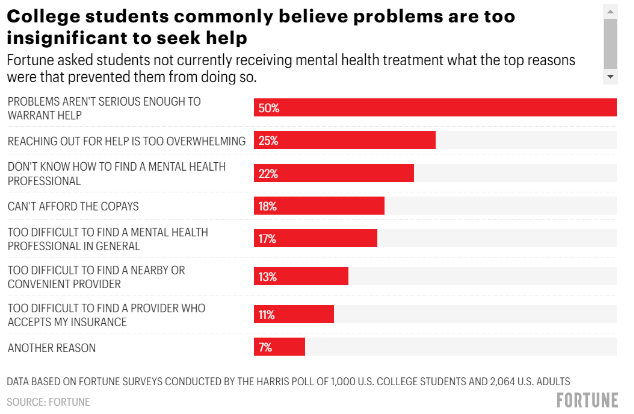Mental illness affects many, and anyone can suffer from it at any time in their life. In recent years, we’ve seen conversations growing around mental health, especially in light of the pandemic and how that’s affected students of all ages.
Yet, there are still so many misconceptions surrounding mental health so students don’t always feel comfortable talking about their feelings and issues with others. Plus, there are many young adults who may not realize a key fact – they aren’t alone in struggling with their mental health. The reality is that many of their peers may feel similarly.
Here, we want to detail why promoting mental health awareness is critical in schools, and how to support students in and out of the classroom.
Young adults are overwhelmed.
Today, we’re experiencing a mental health crisis. Stress, anxiety, and depression are trending off the charts for young adults.
Based on a 2021 meta-analysis of 192 studies, it was found that the average age of onset for a mental health condition was 14.5 years of age!
When it comes to mental health disorders, the Centers for Disease Control and Prevention (CDC) report that ADHD, anxiety problems, behavior problems, and depression are the most commonly diagnosed mental disorders in children, with some conditions occurring together. From 2016-2019, 9.4% of children between the ages of 3-17 were diagnosed with anxiety while 4.4% were diagnosed with depression. While these numbers may seem small, they represent millions of school-age students struggling.
These struggles lead to concerns surrounding depressive episodes, substance abuse, and the risk of suicide. In the 2018-2019 survey of children ages 12-17 years, over 36% shared that they had experienced persistent feelings of hopelessness, 4.1% had a substance use disorder, and over 15% made a suicide plan.
The reason?
According to a Harris Poll, students shared that the top reasons circled back to school, work, and their future.
Plus, here’s the other challenge for students (high school or college):
Navigating their mental health also comes with dealing with the stigma attached to seeking help. According to psychology experts Dr. David Vogel and Dr. Nathaniel Wade, this stigma can be related to society’s perception or be a self-applied mental health stigma, which these experts point out, can be an especially strong influence.
They note:
“In this case, we argue that the role of self-stigma in the decision to seek help might be even more pronounced because it is difficult for many to both acknowledge the need for professional help and not feel a sense of failure or loss as our society portrays needing help as a weakness.”
Students accessing help is a complex issue, as Fortune details here in the case of college students:

The reality is that students have a number of thoughts and influences in their life that impact the way that they’re advocating for their mental health these days. In some instances, mental health may not be a topic of conversation between friends or at the dinner table.
At the end of the day, students should feel like school is a safe space, where they can reach out to a teacher or administrator without feeling ashamed or embarrassed.
Mental health disorders are a massive challenge for school-age children. Supporting and educating students on how to navigate mental health challenges has never been more urgent.
Mental health is just as important as math.
In the same way that we need to be able to do basic math calculations for daily tasks like calculating the tip at a restaurant or adding up items in our online shopping cart, knowing how to take care of our mental health is a key part of living our everyday lives.
Studies show that mentally healthy people feel more grateful and optimistic on a daily basis, and are better equipped to be able to navigate the transformative-type moments in everyday life.
When it comes to relationships, those that are mentally healthy are more willing to help those around them, are less likely to feel envious of others, and are able to set healthy boundaries.
Mental health is something that everyone needs to take care of, but it can be especially hard when you’re young and still figuring out who you are in an age of social media and constant comparisons online.
As leaders and educators, there are things we can do to help students stay mentally healthy (even with limited time and budgets), knowing that the outcome of investing in students’ mental health pays massive dividends.
It’s one thing to talk about it. Here’s how to actionably support student mental health in the classroom.
1. Create an open environment.
The most important factor in laying a foundation for supporting students is discussing mental health openly so that every student becomes more familiar with expressing their emotions and feels safe doing so.
Alongside this, it’s essential to teach students how to recognize the signs of mental illness in themselves and others. As a teacher or administrator, this requires knowing how to spot the signs yourself. Mental Health First Aid is an example of a training program that can help here.
When students know how to vocalize their feelings and recognize symptoms, they are better able to identify the moments when they need help, leading them down a path toward feeling confidently in control of their health.
2. Teach coping and self-care skills to students.
In 2023, self-care is much more than applying a face mask and taking a bubble bath. (Although we love these activities too.)
Self-care is about teaching kids the practices and behaviors that teach students how to take care of their minds and make them the “home” they want to live in for the rest of their life.
As educators, practices that can be brought into the classroom, and encouraged outside of it, include:
- Mediation (even if it means allocating a minute in class for mindfulness)
- Deep-breathing (here’s a few exercises you and your students can use)
- Playing relaxing music or nature sounds
- Supporting student-initiated groups (from peer support to yoga)
- Gratitude journaling
In the Project OTY Build YOUR Roadmap program, we help students support their mental health – not only by teaching students how to navigate obstacles (aka transformative-type moments) but also by practicing gratitude, including providing a space in our platform for students to input their gratitude “journaling sessions”.
3. Rethink screen time.
Students spend hours on their cell phones every day (the average for teens is 9 hours). As many of us now know, too much screen time has major negative effects on students’ mental health.
On one hand, they’re not getting enough face-to-face interactions with other people (and while texting is an important way to communicate, it’s not the same as having a conversation).
On the other, they’re being bombarded with information left and right from every social media platform imaginable.
We can’t deny – reducing screen time plays a vital role in addressing young adults’ mental health.
According to a study from 2018 in the Journal of Social and Clinical Psychology, reducing screen time to 30-60 minutes per day of social media was the optimal level to really make a difference in alleviating students’ feelings of depression and loneliness.
While ungluing students from their phones tends to be tricky (to say the least), there are ways to harness screen time that helps student protect their mental health in the journey toward less screen time.
There is now a list of helpful apps that teachers or school counselors can share with students for support in the event they can’t access the school’s counseling services or therapy.
For example, the app notOK was developed by a struggling teen and her brother as a free resource for other teens. This app gives teens multiple tools, including text message scripts to take the guesswork out of asking for help and easy access to a “call button” to get immediate help and access to resources, while also sharing their location.
Other platforms are helping schools change texting to be a way students connect to get help, such as with the case of SchoolPulse.
4. Educate & connect to available resources.
If you were to ask your students if they knew where to access help for their mental health when they needed it, what do you think they would say?
We ask, because, in a Harris Poll, 72% of college students weren’t sure of where to go on campus to receive mental health treatment.
While college and high school environments may vary in the services available, it’s important for all schools and administrators to make information easily accessible for students on where they can seek help (i.e. who to get in touch with and where to go) and the steps to getting help, including any restrictions that might apply to services.
As far as knowing when to connect certain students to available resources, well… that’s easier said than done, right?
When it comes to providing the “right” resources at the “right” time, the best approach is to help your students tell you when and what resources they may need.
For example, when we lead schools through our Build YOUR Roadmap program, each student completes a Project OTY Roadmap that helps them map out their future plan and the questions and obstacles they’re facing. This includes identifying the fears they feel are holding them back. From there, students have the ability to download and share their Roadmap with teachers and counselors.
With access to the Roadmap, educators have better insight into student struggles and can supply resources based on the fears, life goals, and Next Steps (action items) that each student has identified. Click here to learn more and demo the platform.
5. Help your students feel seen and heard.
Each and every student needs to feel heard, accepted, and respected in order to thrive.
At times, your students will feel isolated, lonely, and depressed. They may experience feelings of not being heard or respected. They might feel misunderstood or judged for their differences. Sometimes this can lead to a sense of not being accepted by others.
Teachers have the power to help students overcome these challenges to achieve their full potential at school and in life!
Here’s one simple way to provide support:
- Giving feedback and pep talks based on the Unique Strengths you notice that a student possesses.
For example, a student in your class (let’s call him Aaron) recently completed a science project that really showcased his problem-solving skills.
Aaron may not fully realize his skills, especially at a time when he’s feeling anxious or uncertain. As an educator, being able to lean in with a simple reminder of his personal strengths (in this case, his incredible ability to problem solve) can be an action that empowers him to overcome future transformative-type moments.
- Another way to look at this would be to help your students feel heard when they share their wants and needs.
One of your students (Mari) shares that they’re interested in a job in marketing, but they “don’t know where to start in even thinking about a career”.
As the upcoming job fair rolls around, you find out that a local marketing agency will be attending.
Circling back to Mari, you let her know that you remember her expressing her feelings of uncertainty and offer to help connect her with the team on the day of the job fair.
Small, compassionate comments that show students you’re paying attention – go far.
Conclusion
Mental health is about more than just feeling good. For students in today’s world, it’s a vital part of feeling safe and secure, having healthy relationships with friends and family, doing well in school, and being able to build a future for themselves.
Mental health awareness should be taught in schools from a young age. It’s an important part of overall health and well-being, but it’s also something that many kids don’t know how to deal with when they’re faced with stress at school or outside pressures. Young adults are overwhelmed with stress, anxiety, and depression–and they don’t know where to turn for help.
It’s important to remember that mental illnesses are not something students “get over” or “snap out of”, they are conditions that require ongoing care to manage, including by mental health professionals outside of school.
With mental health being such an important part of our lives, it’s vital that we teach kids how they can look after their own mental well-being in the same way we prioritize teaching them about basic math calculations or their physical health.
Even better? Providing all these mental health resources and knowledge while students are still young enough that these lessons stick with them for life! The earlier in life that we can support students, the better off they’ll be in the years to come.
At Project OTY, we’re helping students and educators connect and have more powerful conversations that reflect how students feel about themselves, their Unique Strengths, and their future. In our Build YOUR Roadmap program, we’re empowering students with the mindset tools and exercises to help them believe in themselves and their future.
We are working with high schools and colleges to holistically prepare their students from day one of class to graduation day.

